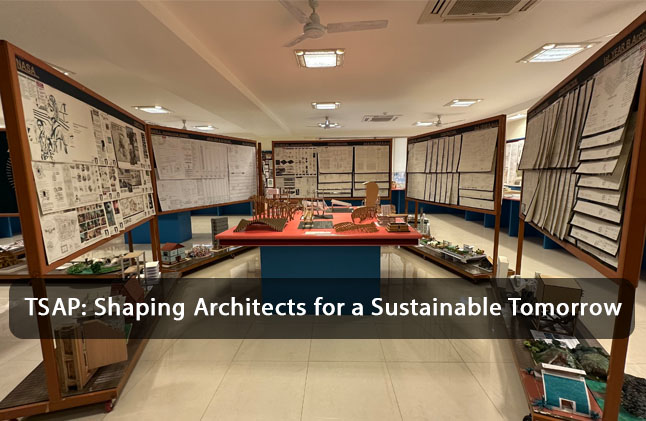
In a city that vibrates with architectural complexity and diversity like Mumbai, Thakur School of Architecture and Planning (TSAP) isn’t merely an institution of learning, but a design incubator of socially conscious and future-oriented architects. Founded in 2014, TSAP wasn’t established to simply educate architects—it was established to revolutionize the very concept, pedagogy, and practice of architecture in India.
It is approved by the Council of Architecture (COA), All India Council for Technical Education (AICTE), Directorate of Technical Education (DTE), and Government of Maharashtra. The institute is affiliated to the University of Mumbai. It is an unaided and Hindi linguistic minority institute.
Greater than a college, TSAP is a philosophy in action—a conviction that architecture has to react to human needs, ecological harmony, and cultural continuity. Supported by a firm basis of sustainable design thinking, scholarly depth, and international consciousness, the institute serves up rigorous training together with visionary learning.
What Makes TSAP Unique? A Curriculum Designed for Relevance
- Purpose-Driven Design Education
TSAP was born on the premise that architecture should be more than a profession—it should be an act of intervention in society. The course is deliberately structured to instil students with the skill to design for sustainable development, and to help address housing, public space, and environmental degradation problems.
Not only are students taught to design form—they’re guided to consider critically the ways in which space influences behaviour, community, and ecology.
- Interdisciplinary Synthesis of Knowledge
Architecture education at TSAP is presented as a multidisciplinary endeavour that synthesizes ideas from engineering, environmental science, sociology, city planning, computing technologies, and humanities. Synthesizing multiple disciplines guarantees each TSAP alumnus views architecture as neither a singular action of design nor a mono-faceted solution but as an intricate system responding to multiple variables.
- Infrastructure for Innovation
TSAP’s built environment mirrors its ethos. The institute offers state-of-the-art facilities, including:
- Fixed large design studios that serve as collaborative think tanks
- A specially outfitted construction yard for experimentation
- Sophisticated laboratories for environmental simulation and material research
- Twinned research cells where one can innovate in design and construction methods
This tangible culture of creativity and investigation is critical to the formation of well-educated architects to meet the realities of practice.
Pedagogical Highlights: TSAP’s Signature Approach
Project-Based and Research-Led Learning
TSAP has a studio-based and experiential learning system in which each academic year is based on live projects, site studies, and context-specific design challenges. Skills are developed through:
- Design fests, symposiums, and global conferences
- Industry expert-led workshops
- Paper presentations and critiques with visiting faculty and international experts
This intensive environment not only nurtures creativity but builds professional acumen and critical thinking.
Global Perspective, Local Application
The way student and faculty exchanges, TSAP develops a world design consciousness complemented by a focus on vernacular knowledge and local identity. Students are inspired to see architecture both in broad macro-urban and in focused micro-contextual terms, thus ensuring that what they produce will be of the world but grounded in place.
Value-Based Architecture Education
Embedded within TSAP’s education strategy is an inherent value framework that informs professional demeanour as much as it molds character:
- Integrity and Transparency in all academic and administrative processes
- Entrepreneurship and Research Orientation to foster innovation
- Discipline and Team Spirit to facilitate collaborative learning
- A Humane Touch, so that students continue to be socially aware designers
TSAP also focuses on intellectual ethics and intellectual property rights, making students ready to handle a future where innovation and ownership are hand-in-hand.
Commitment to Societal and Environmental Responsibility
TSAP’s commitment to sustainability is not abstract—it is infused in every level of education. Students learn and practice concepts of:
- Passive design techniques
- Green building ratings
- Urban resilience and low-impact development
- Models of affordable and inclusive housing
TSAP is committed to molding architects who don’t just react to the environment—they anticipate, defend, and regenerate it with architecture.
A Vision for the Future: Combating Brain Drain, Empowering Mumbai
One of TSAP’s core goals is to retain and develop architectural talent in Mumbai. By offering world-class education in the state, TSAP addresses the necessity for prospective architects to look elsewhere for opportunities. The institute sees itself as a centre for regional innovation and international collaboration, with its alumni set to dominate not just in India but on global platforms.
Conclusion: Building the Future with Intention
At TSAP, architecture is not just design—it is a promise to humanity, heritage, and habitat. From its pedagogy of sustainable design to its state-of-the-art infrastructure and integrated value system, every aspect of the institute is thoughtfully designed to nurture architects of impact.
Here, students don’t learn to design buildings—they learn to design futures.
Thakur School of Architecture and Planning isn’t only moulding professionals—it’s moulding a better world, one sensitive design at a time.
